Seizure of Abu Musa and the Greater and Lesser Tunbs
| Abu Musa and the Greater and Lesser Tunbs Dispute | |||||||||
|---|---|---|---|---|---|---|---|---|---|
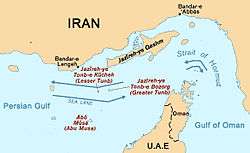 Map of the Strait of Hormuz | |||||||||
| |||||||||
| Belligerents | |||||||||
|
|
| ||||||||
| Commanders and leaders | |||||||||
|
|
| ||||||||
| Casualties and losses | |||||||||
|
3 KIA 1 WIA | 1 Killed | ||||||||
The Seizure of Abu Musa and the Greater and Lesser Tunbs occurred on 30 November 1971 when British forces withdrew from the islands of Abu Musa, Greater Tunb and Lesser Tunb. Immediately following British withdrawal from these islands, Iranian marines laid siege to and gained territorial control of the islands for the first time since 1921.
Causes
The Tunbs were in the dominions of the kings of Hormuz from 1330 until 1507 when they were invaded by Portugal. The Portuguese occupied the island until 1622, when they were expelled by Shah Abbas. The islands were occupied by the British Empire on 7 June 1921, and they were put under administration of the Emirate of Sharjah. In 1971, shortly before the end of the British protectorate and the formation of the UAE, Iran assumed partial control of Abu Musa under an agreement of joint administration together with Sharjah. A day later on 30 November 1971, Iran seized the Islands and took control over them.[1][2][3]
Memorandum of understanding
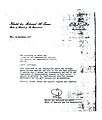 Ruler of Sharjah asks British Foreign Secretary for Iranian acceptance of the MOU.
Ruler of Sharjah asks British Foreign Secretary for Iranian acceptance of the MOU.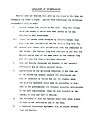 The Memorandum of Understanding as attached to the letter of 18 November 1971 from the Ruler of Sharjah to the British Foreign Secretary.
The Memorandum of Understanding as attached to the letter of 18 November 1971 from the Ruler of Sharjah to the British Foreign Secretary.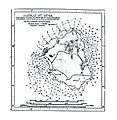 Official map of Abu musa island attached to the Memorandum of Understanding of November 1971.
Official map of Abu musa island attached to the Memorandum of Understanding of November 1971. Letter of 24 November 1971 from British Foreign Secretary to the Iranian Minister of foreign Affairs asking for Iranian acceptance of MOU.
Letter of 24 November 1971 from British Foreign Secretary to the Iranian Minister of foreign Affairs asking for Iranian acceptance of MOU. Letter of 25 November 1971 from Iranian Foreign Minister to the British Foreign Secretary concerning Iran’s acceptance of the MOU.
Letter of 25 November 1971 from Iranian Foreign Minister to the British Foreign Secretary concerning Iran’s acceptance of the MOU. Letter of 25 November 1971 from the Iranian Foreign Minister to the British Foreign Secretary spelling out Iran’s conditions and warnings relevant to Iran’s acceptance of the MOU.
Letter of 25 November 1971 from the Iranian Foreign Minister to the British Foreign Secretary spelling out Iran’s conditions and warnings relevant to Iran’s acceptance of the MOU.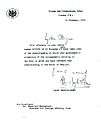 Letter of 26 November 1971 from British Foreign Secretary to the Iranian Foreign Minister informing him that Iran’s conditions and warnings had been conveyed to the Ruler of Sharjah. (It was agreed that an absence of reply from the Ruler of Sharjah to this letter would amount to his acceptance of Iran’s conditions and warnings.)[4]
Letter of 26 November 1971 from British Foreign Secretary to the Iranian Foreign Minister informing him that Iran’s conditions and warnings had been conveyed to the Ruler of Sharjah. (It was agreed that an absence of reply from the Ruler of Sharjah to this letter would amount to his acceptance of Iran’s conditions and warnings.)[4]
The operation

On 30 November 1971 the Imperial Iranian Navy seized the islands under small resistance of the tiny Arab police force stationed in there.[5] Despite the agreement between Sharjah and Iran, Ras Khaima ruler resisted the Iranian troops that were sent to the Tunbs.[6] The Iranians planes kept shooting the police station which made the Arab forces to return fire on ground troops. According to some sources, the Arab civilian population of Greater Tunb was then deported, but according to others the island had already been uninhabited for some time earlier.[5]
Aftermath
In the following decades, the issue remained a source of friction between the Arab states and Iran. Negotiations between the UAE and Iran in 1992 failed. The UAE have attempted to bring the dispute before the International Court of Justice,[7] but Iran refused. Tehran says the islands always belonged to it as it had never renounced possession of the islands, and that they are part of Iranian territory.[8] The United Arab Emirates argue that the islands were under the control of Qasimi sheikhs throughout the nineteenth century, whose rights were then inherited by the UAE after 1971. Iran counters by stating that the local Qasimi rulers during a crucial part of the nineteenth century were actually based on the Iranian, not the Arab, coast, and had thus become Persian subjects.[9] In 1980, the UAE took its claim to the United Nations,[10] but it was rejected by the UN Security Council, and the case was closed.[1][3]
See also
References
- 1 2 Mojtahedzadeh, Pirouz (1993). Countries and boundaries in the geopolitical region of the Persian Gulf. The Institute for Political and International Studies. ISBN 964-361-103-5.
- ↑ Mojtahedzadeh, Pirouz (1999). Security and territoriality in the Persian Gulf. RoutledgeCurzon. ISBN 0-7007-1098-1.
- 1 2 Mojtahedzadeh, Pirouz (2006). Boundary Politics and International Boundaries of Iran. Florida: Universal Publishers Boca Raton. ISBN 1-58112-933-5.
- ↑ Mojtahedzadeh, Pirouz (July 1995). THE ISLANDS OF TUNB AND ABU MUSA. UNIVERSITY OF LONDON.
- 1 2 Schofield, Richard. Borders and territoriality in the Gulf and the Arabian peninsula during the twentieth century. In: Schofield (ed.) Territorial foundations of the Gulf states. London: UCL Press, 1994. 1-77. References on p. 38.
- ↑ Rubin, Barry M. (2002). Crises in the Contemporary Persian Gulf. Routledge. pp. 44–45. ISBN 9780714652672.
- ↑ Heidelberg Institute for International Conflict Research (HIIK)
- ↑ Safa Haeri,
- ↑ Schofield: 35-37.
- ↑ Article about Abu Musa in the Trade & Environment Database of the American University, Massachusetts Archived 22 June 2007 at the Wayback Machine.
External links
- Picture of announcement made to the local residents of Tunb Island about the return of islands to Iranian territory in Arabic and Persian signed by King of Iran
- Eminent scholar on the issue